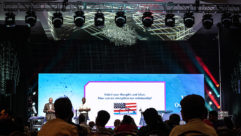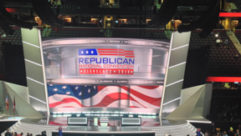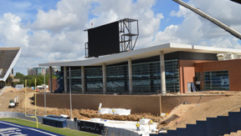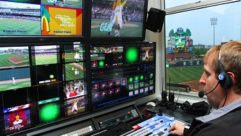Let the Games Begin
Sep 1, 2000 12:00 PM,
Chris Shuler
The sound-reinforcement system installed at Stadium Australia, home to the 2000 Olympic Games, required both quality and versatility.
In terms of magnitude, events do not get much larger or more spectacular than the Sydney 2000 Olympic Games. From mid-September through October 1, some 10,200 athletes and 5,100 officials from 200 countries will converge to take part in 28 tests of skill, speed and stamina. Approximately 5.5 million tickets to Olympic competitions will be sold, giving many a chance to see the events live for themselves, and thanks to 15,000 members of the media scheduled to be in attendance, coverage of the Games will be provided for a staggering estimated audience of 4.5 billion people around the globe.
When the opening ceremonies of the XXVII Olympic Games kick off on Friday, September 15, the world will focus its attention on the largest outdoor venue in modern Olympic history – Stadium Australia at Homebush Bay on the western end of Sydney Harbor. Also known as Olympic Stadium, the $395 million (US) centerpiece of Sydney’s Olympic Park will be used to host many of the Games’ most watched events, including the opening and closing ceremonies, men’s soccer final and all track and field events.
The facility itself is massive. A continuous lower seating bowl surrounds the 400 m athletic track. Above that to the east and west, six levels of grandstands rise up to meet 7.5 acres (3 hectares) of arced translucent polycarbonate roofing. To the north and south, tall open grandstands stretch out from both ends of the pitch. With more than 110,000 seats, 104 private suites and a large number of other public areas – concourses, banquet halls, restaurants, bars, restrooms and function rooms – a powerful and flexible system to handle the venue’s complex audio needs was of paramount concern.
The specification for this system was developed by the team of Andy Prager of Flack and Kurtz, New York City, who served as lead system consultant, along with acoustical consultant Bob Fitzell. Following a highly competitive bidding process among Australia’s leading integration firms, The PA People emerged as the choice to implement the system and to supply custom engineering solutions as well.
After being awarded the project, The PA People, based in Sydney and headed up by Managing Director Chris Dodds, met with the consulting team to fine tune the system design, offering several innovative solutions. Backed by Creative Audio, The PA People’s sibling manufacturing division in Brisbane, many of these solutions featured new and custom technology never used in a project of this size.
“As an integrator, The PA People uses products from many manufacturers,” said Dodds, “but because of our expertise in the engineering field, if we feel a product doesn’t exist to meet the client’s needs, then we will custom-engineer a solution through our sister company, Creative Audio. Working in close partnership with forward-thinking manufacturers, we are able to deliver solutions for our clients that would be otherwise unavailable.”
Challenges
“In Australian terms, the Olympic Stadium is unique,” said Dodds. “It’s one of the few venues here that is like an American stadium due to a much higher standard of finish. It’s not simply a soccer stadium that you visit for a game and then leave. This venue has a full complement of facilities common in the United States – conference rooms, luxury suites, restaurants and bars and other amenities. Most stadiums in our country simply don’t offer that sort of functionality. However, since we had been to the Super Bowl and a number of other large events in the United States, we had a reasonable understanding of what needed to be achieved.”
After a careful assessment of the venue, Dodds and his team determined the challenges that would need to be addressed. The system needed to deliver audio coverage to a large number of people in many different regions and locations. They settled upon a distributed PA system to cover the stadium bowl and then set about designing a 70 V system to cover more than 150 suites and individual rooms.
Further, the system had to support easy, flexible audio signal routing to any zone, depending on the requirements of a particular event. Crowd mics, paging mics and background music sources would have to be properly routed and managed throughout the site. For example, some pre-recorded announcements would need to be heard in all zones; others would need to be routed to only specific zones.
Following the Olympic Games and sub-sequent Paralympics held in October, the temporary open stands on the north and south ends of the field are to be dismantled and replaced with smaller, roofed seating areas. At the same time, the lower tier of bowl seating will be pulled forward towards the pitch. Aside from reducing the overall seating capacity of the venue to 80,000, this eventual setup will be better configured to host future soccer and rugby matches and large-scale concert events. With these upcoming physical stadium changes in mind, the front-of-house bowl system would need to be as versatile as the back-of-house setup.
Audio quality for all coverage spaces was another top priority. A large stadium is rarely the first environment brought to mind when thinking about superior audio reinforcement. The PA People wanted to combat that mentality with a system that provided both outstanding intelligibility and full-range fidelity.
Amps and loudspeakers
Based on a history of success with the product, The PA People installed an all-Crown amp system. A total of 94 Crown Macro-Tech amps and 56 Crown Com-Tech amps are divided among the stadium’s four amp rooms, located on level seven at the north and south ends of both grandstands. The Macro-Techs, made up of three different models based on specific loudspeaker power requirements, drive the FOH bowl system. The east and west grandstands each use eight Bose Panaray LT clusters hung off the leading edge of the roof. These clusters consist of three mid-high boxes and four bass cabinets in a cardioid array. Six more clusters per side are flown from the roof structure to provide additional coverage to shadowed areas. The rear areas of the lower seating tier are covered by 56 cabinets mounted on the underside of the level three overhang.
Loudspeaker clusters for the north and south temporary grandstands are positioned on large lighting trusses on either side of each seating area. Each tower comprises 14 Bose loudspeaker cabinets – four mid-high cabinets at the upper level, two mid-high cabinets at the lower level and eight bass cabinets in a directional column array. An additional 32 cabinets provide coverage to the rear areas of the lower seating tier under level three. Ultimately, the loudspeaker system is designed to reinforce events with a center field focus. Highest intelligibility sound is provided to patrons seated in the east and west stands, particularly for events with an audio source centered on the field’s halfway line.
For added flexibility, the system can also be reconfigured to provide sound reinforcement support for events where the audio focus is in one of the end zones, such as a major concert where a touring sound company would provide its own FOH system. Each cluster in the stadium’s system is capable of being individually delayed to create an audio focus wherever the client desires.
The 56 Com-Tech amps in four different models drive the system’s BOH setup, which features 1,600 various Bose background loudspeakers grouped into 29 zones. Each zone consists of a number of cable home runs and one or more amp channels. Amp channels can be reallocated to five additional zones that are not used in the default state.
Control elements
“Needless to say, designing and installing the sound reinforcement system for the Olympic Stadium brought a new set of challenges,” said Dodds. “The consultant nominated a complete United States fiber-optic signal distribution and a separate control system. However, since neither was supported in Australia, we chose to recommend an alternate technology.”
One part of the alternative was Peavey’s MediaMatrix, set up for use with CobraNet. CobraNet is a proprietary digital audio protocol introduced by Peak Audio that is one of the standards for delivering audio via 100Base-T Ethernet. With CobraNet, participating manufacturers can distribute more than 64 channels of full bandwidth (20 Hz to 20 kHz) audio in real time on either Cat5 or fiber-optic cable. The world’s first MediaMatrix install using CobraNet, its primary function was to serve as the control system’s router, in addition to offering some basic ducking and dynamics functions.
The second major component of the control system was Crown IQ in the first application to use Crown’s new USP2 modules. These modules plug into the back of each Crown Macro-Tech or Com-Tech amp to provide eight bands of parametric EQ per channel plus crossover, delay and load monitoring at the amp itself.
Working in tandem with Crown, Creative Audio also developed a new module that piggybacks one of its custom-built cards onto a USP2 card and allows CobraNet to be run directly into the stadium’s Crown BOH amps. Known as a USP2-CN, the hybrid module features dual redundant CobraNet ports and two analog audio inputs to enable local audio sources to be brought onto the network.
“With 56 Com-Techs equipped with USP2-CNs, we have 112 BOH channels that travel via CobraNet,” said Dodds. “At the same time, we only have 40 outputs coming out of the MediaMatrix to feed all of those amplifiers. So there are 40 logical paging zones, but we can dynamically allocate different amplifier channels to those zones.
“So, for example, in a sporting event, you would have all of level zero – the whole public entry level concourse – designated as one zone. But for a concert event, if the stage is on one side of the field, they may well want to section off part of that public concourse for VIPs, or they may want to section off part of it as a BOH area. If they want to do that, we can use CobraNet and reassign the amplifiers that control those few groups of speakers onto a different paging zone.
“We can reconfigure the whole building’s paging zone structure without needing 112 outputs out of the MediaMatrix. CobraNet provided us the ability to easily reconfigure the system amp by amp and zone by zone. In other words, it afforded us a virtual matrix whereby any combination of inputs can be routed to any combination of outputs. It’s a whole new level of flexibility for patching.”
Control specifics
Using a combination of Crown IQ, Peavey MediaMatrix, Peak Audio CobraNet and a number of Creative Audio components, The PA People implemented a control system that afforded intuitive operation. Located in the stadium’s control room on level five of the west grandstand, more than 300 feet (91.4 m) up from the track’s finish line, is a MediaMatrix processor and software (v. 3)controlling the routing of all audio. This pairing also provides some initial processing functions, including EQ, delay, limiting and mixing.
Stadium Australia benefits from the latest version of MediaMatrix, which offers CobraNet as an option. This version uses a series of RJ-45 connectors on the rear of the product in place of Peavey’s traditional break out box (BOB) interface.
Peavey’s new CobraNet Audio Bridge (CAB) boxes provide an interface between MediaMatrix outfitted with CobraNet DSP cards and all of the system’s analog inputs and outputs. Unlike Peavey’s previous BOBs, the new CAB boxes can be used remotely to provide either eight analog audio inputs (CAB8i) for paging stations or crowd mics or eight analog audio outputs (CAB8o) for the FOH amps not equipped with CobraNet.
The CAB boxes are located in the four amp rooms, the communications room at the southeast end of the field on level one, and in the main control room – basically everywhere that analog audio is used. Audio signals are delivered between the CABs and the MediaMatrix hub via Cat5 cable on short runs, such as between the control room and west grandstand amp rooms, and fiber-optic cable on longer runs, including the span between the communications and control rooms.
Another PC in the control room loaded with Crown IQ for Windows software (v. 4) and IQ hardware controls, monitors and tests the amp system. MediaMatrix routes and provides initial processing for the audio signals, and Crown IQ provides control over amp volume levels, loudspeaker load monitoring and digital signal processing – EQ, crossover, signal delay, compression and filters – for each individual channel via the USP2 and USP2-CN cards plugged into the backs of the amps. “With 150 amplifiers requiring separate processing on every channel,” said Dodds, “a traditional system providing everything USP2 provided but driven from the control room would have generated 300 outputs. By using the modules, we created a system that generated only 60 outputs, which is a significant savings Plus, the way we’ve implemented the system using CobraNet, we have attained several levels of functionality that you wouldn’t get inexpensively in a centrally located process system.”
Creative Audio also chose to use Page Server, its proprietary software GUI run on a third computer, this one QNX, which is a 32 bit real-time OS designed for processed control applications, particularly in larger systems. This serves as an interface overlooking IQ, MediaMatrix and all of Creative Audio’s RS-485 devices, including paging stations and wall panel controllers in the suites and source selection panels in the banquet halls.
The actual user interface exists on a PC running Windows NT. Control and monitoring of the system through Page Server is accomplished via a traditional non-audio 10Base-T Ethernet network among the operator’s PC and the three main control room computers. System management is not solely confined to the control room; RJ-45 Ethernet sockets are available in a wide number of locations, permitting a laptop to be plugged in to facilitate system control from many places within the venue.
“The operator’s interface is a client to Page Server. This operator’s GUI provides a central point of control that manages everything one would need in a simple fashion. A graphical layout of the venue featuring cluster positions permits loudspeakers to be turned on and off easily. Pre-recorded messages may be scheduled. Alarm messages are displayed if there’s a failure in any component of the system. The external load monitoring devices, Crown SLM-8s, can be controlled. Music can be routed to different zones. In a nutshell, all of the day-to-day system configuration and operation can be controlled via the GUI.”
Although there are engineering interfaces on the IQ, MediaMatrix and Creative Audio servers, this top-level GUI is often the only thing that the operator will have to use. Granted, if an engineer wishes to change the EQ in an amp, he would use the standard Crown IQ for Windows setup, which connects to the same server, communicates with the amps and allows them to create a preset or change it in cue. MediaMatrix RAMM does the same with MediaMatrix, and CA Engineering, The PA People’s engineering application, does the same for Page Server for things like setting paging station configuration. Once changes have been made to any or all of these things, however, the engineer simply saves it as a preset. Then the operator can call the whole system configuration up on the GUI when appropriate.
“In operational terms, we can manage each of the three servers from an engineering perspective, and then the operator simply uses one application,” said Dodds. “All that needs to be done to set up the system for a rugby match is to recall the preset for that type of event on the GUI. Then the system is immediately configured for that application. If the operator wants to add a paging zone, he or she only needs to make a few clicks on a mouse to set it up.”
The stadium’s audio complement is further rounded out by a performance audio system for sports presentation centered around a Soundcraft K3 Theatre desk with 16 mono and 8 stereo channels.
“When you’re dealing with events that use playback devices,” said Dodds, “you need a number of dedicated stereo channels. The K3 is a true presentation console. It is transformer-balanced on the mic ins, which is critical. By definition, a microphone in a stadium comes from a long, long way away.”
End results
Dodds said, “Our control system does everything that the originally specified system would do and more. It has all of the same sorts of features, but it uses genuineWindows applications and RS-485 instead of RS-422 so that you don’t have to do a homerun for every control port. In fact, we were able to put two complete systems into the job in a redundant pair for close to the same price as the other system would have cost for one.”
Certainly essential was the capability for all audio channels to be distributed on common fiber-optic and Cat5 cable rather than on many miles of copper wire. Cable and installation costs are dramatically decreased by going the CobraNet route, not to mention the savings that come from not having to purchase and install patchbays and rackmount devices.
More important than the cost issue, the system’s flexibility is perhaps unparalleled for a venue of this size. If this had been a traditional analog system, every time the stadium switched over for a different event, it would require a good deal of repatching and tweaking. This system, however, requires only that a preset be recalled to have all of the rerouting done, zones reassigned and loudspeakers properly delayed.
This flexibility does not extend to only the control room. Corporate clients renting the stadium’s banquet rooms are able to select from a variety of program options and adjust their volume levels.
A healthy number of feeds, provided for media coverage, are available at a variety of locations. Staff members may temporarily install Creative Audio-built paging stations to provide paging facilities and pre-recorded announcements in certain areas when necessary, and intuitive control of the entire system is available from numerous locations around the stadium just by plugging a PC laptop into one of the stadium’s many RJ-45 sockets.
To date, the system has managed to prove itself on a number of occasions. Several rugby matches have packed in well over 100,000 spectators each, with two international soccer events also bringing in the crowds. The San Diego Chargers and Denver Broncos even held a pre-season exhibition game at Stadium Australia. As far as concerts go, the Bee Gees performed the first major show, calling upon the stadium’s system to provide audio for the entire eastern stand while the concert sound company’s FOH rig covered the lawn seats.
“On one of the days that we were first commissioning the system and truly giving it a good listen, the people from Olmstead Productions were on site to see the facility,” said Dodds. “OP serves as a game enhancement consultant to the NFL and has produced over 400 halftime shows and sports entertainment events, including the Broncos vs. Chargers game we had here. Peter Dergee, OP’s vice president, commented to us that this was the best sound he had ever heard in a stadium. Coming from a guy of that caliber, someone who has been in as many stadiums as he has, that told us we had definitely done something right.”










